Habesha women of Tigray origin
Historically, the entire Ethiopians irrespective of their ethnic, cultural, linguistic or historical origins were erroneously referred to as Habesha or Abyssinians, but the people who were really Habesha were/are these three major ethnic groups: the Amhara, the Gurage, the Tigray-Tigrinya and other satellite groups like the Agew, and the Beta Israel who are from the North part of Ethiopia.
It was documented that around first century A.D., some Hamitic-Semitic peoples (Sabaean traders) from South Arabian came into contact with native people and intermarried. Their off-springs were referred to as “Habesha”, which means “people of mixed blood”. Their land (Tigray, Begemdir, Gojam, Northern Shewa, and Welo) was later termed Abyssinia. It was only when the Abyssinia state exhausted its scarce resources that its leaders expended its frontiers South and Westward in order to amass the resources needed to feed their subjects. Per advice from Count Pietro Antonelli, an Italian with geographic Society mission in Abyssinia, the state of Abyssinia combined with the newly added states of the South and the West, were later referred to as “Ethiopia”
On why some Jamaican Rastafarians associate themselves as with Habesha culture and ethnicity,
according to ancient Ethiopian manuscript in Geez discovered by Meri Ras Aman Belay, in the ruins of an Ethiopian church in Nubia, a part of the Ethiopian Empire, both the Amara (Amhara) and the Oromo are the descendants of one man or father- Melchizedek, King of Salem the highest priest of God on Earth, founder of Jerusalem to whom Abraham and other kings bowed and paid tithes to receive his blessings. It continued that Deshet a descendant of Shem gave birth to four sons, one of which was named Maji. It is said that "Maji begat Mara (Amara) and Jema or Jama (the people who settled at the River Jema in today's Shoa, a river they named after their tribe. The Jamacans of Jamaica were captured by Ahmed Gragn when they fought him fiercely, taken from there, sold as slaves to Arabs who sold them to European slave traders, who sold them in Jamaica)."
Habesha beauty
Isaias Afwerki, a Habesha of Tigrinya ethnicity. is the first President of the State of Eritrea and current president of Eritrea. He has held the position since Eritrea`s independence in 1993
Today the Habesha group of the Amhara, Tigray and Gurage peoples make up about 35.5% of Ethiopia's population (c. 24.6 million Amhara, 5.5 million Tigray, 1.8 million Gurage), while the Tigrinya and Tigre combined make up 85% (55% plus 30%, respectively) of Eritrea's population
(c. 5 of 5.9 million).

Habesha wedding
Origin of the Name Habesha
Habesha is believed to have given rise to the term "Abyssinia" which refer to Amharic and Tigrinya speaking Christian Ethiopians. The modern term derives from the vocalized Ge'ez: ሐበሣ Ḥabaśā, first written with a script that did not mark vowels as ሐበሠ ḤBŚ or in "pseudo-Sabaic as ḤBŠTM". The earliest known use of the term dates to the 2nd or 3rd century AD South Arabian inscription recounting the defeat of the Aksumite Negūs ("king") GDRT of Aksum and ḤBŠT.
Beautiful Habesha girl with traditional Habesha hairstyle
The term "Habashat" appears to refer to a group of peoples, rather than a specific ethnicity. A Sabaean inscription describes an alliance between the Himyarite king Shamir Yuhahmid and Aksum under King `DBH in the first quarter of the 3rd century AD. They had lived alongside the Sabaeans, who lived across the Red Sea from them for many centuries:
"Shamir of dhū Raydān and Himyar had called in the help of the clans of Habashat for war against the kings of Saba; but Ilmuqah granted... the submission of Shamir of dhū Raydān and the clans of Habashat."
Habesha kids
The term "Habesha" was formerly thought by some scholars to be of Arabic descent because the English name Abyssinia comes from the Arabic form. (Arabs used the word Ḥabaš, also the name of an Ottoman province comprising parts of modern-day Eritrea and Ethiopia). South Arabian expert Eduard Glaser claimed that the hieroglyphic ḫbstjw, used in reference to "a foreign people from the incense-producing regions" (i.e. Punt, located in Eritrea and northeast Ethiopia) used by Queen Hatshepsut c. 1460 BC, was the first usage of the term or somehow connected. This claim was repeated by others; however, this etymology is not at all certain, given the large time difference in the usage of the terms.
Reitrean Habesha bride and groom dancing at their wedding reception
Language
Habesha people speak Ethiopian Semitic languages, including the classical language Ge'ez. The kingdom of DʿMT wrote proto-Ge'ez in Epigraphic South Arabian as early as the 9th century BCE; later, an independent script replaced it as early as the 5th century BCE.
Ge'ez literature is considered to begin with the adoption of Christianity in Ethiopia and Eritrea and the civilization of Axum in the 4th century BCE, during the reign of Ezana. While Ge'ez today is extinct and only used for liturgical purposes in the Eritrean Orthodox Tewahedo Church and Ethiopian Orthodox Tewahedo Church, many related Ethiopian Semitic languages continue to be spoken such as Tigre, Tigrinya, Amharic, Harari, Gurage and Argobba. Some of these languages, such as Tigre, are traditionally written in the Arabic script.
History
Abyssinian civilization had its beginnings in the areas of present-day Ethiopia and Eritrea. The first kingdom to arise was that of D'MT in the 8th century BC. The Kingdom of Aksum, one of the powerful civilizations of the ancient world, was based there from about 100 AD to the 10th century AD. Spreading far beyond the city of Aksum, it molded the one of the earliest cultures of Ethiopia and Eritrea. Architectural remains include finely carved stelae, extensive palaces, and ancient places of worship that are still being used.
Emperor Menelik II. The man who defeated the Italians in the Battle od Adwa
Antiquity: Throughout history, populations in the Horn of Africa had been interacting through migration, trade, warfare and intermarriage. Most people in the region spoke Afroasiatic languages, with the family's Cushitic and Semitic branches predominant. As early as the 3rd millennium BCE, the pre-Aksumites had begun trading along the Red Sea. They mainly traded with Egypt. Earlier trade expeditions were taken by foot along the Nile Valley. The Egyptians' main objective in the trade from the Arabian Peninsula region was to acquire myrrh, which the Horn of Africa region had in abundance (the Egyptians referred to this region as the Land of Punt).
The Kingdom of Aksum may have been founded as early as 300 BCE. Very little is known of the time period between the mid-1st millennium BCE to the beginning of Aksum's rise around the 1st century CE. It is thought to be a successor kingdom of Dʿmt, a kingdom in the early 1st millennium BC most likely centered at nearby Yeha.
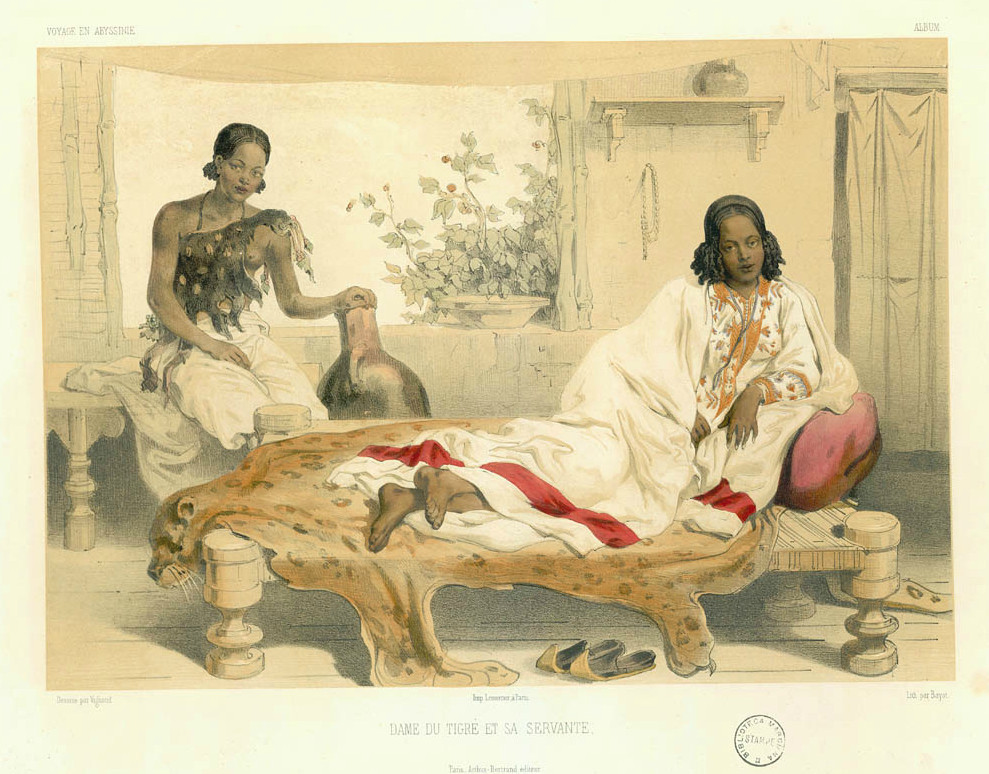
The Kingdom of Aksum was situated in Northern Ethiopia and Eritrea with its capital city in Northern Ethiopia. Axum remained its capital until the 7th century. The kingdom was favorably located near the Blue Nile basin and the Afar depression. The former is rich in gold and the latter in salt: both materials having a highly important use to the Aksumites. Aksum was accessible to the port of Adulis, Eritrea on the coast of the Red Sea. The kingdom traded with Egypt, India, Arabia and the Byzantine Empire. Aksum’s "fertile" and "well-watered" location produced enough food for its population. Wild animals included elephants and rhinoceros.
From its capital, Aksum commanded the trade of ivory. It also dominated the trade route in the red sea leading to the gulf of aden. Its success depended on resourceful techniques, production of coins, steady migrations of Greco-Roman merchants, and ships landing at Adulis. In exchange for Aksum’s goods, traders bid many kinds of cloth, jewelry, metals and steel for weapons.
At its peak, Aksum controlled territories as far as southern Egypt, east to the Gulf of Aden, south to the Omo River, and west to the Nubian Kingdom of Meroë. The South Arabian kingdom of the Himyarites and also a portion of western Saudi Arabia was also under the power of Aksum. Their descendants include the present-day ethnic groups known as the Amhara, Tigray and Gurage peoples.
Medieval Period: The Habesha are those people and the Amhara The Habesha history goes back to the Axumite Empire in the first century A.D. This race is named after the Biblical figure Sem like Cush. It is the race that entered Africa around 1000BC from the Arab peninsula crossing the Red sea. They are well known as Habesha, Sabians, or Agazian and are related to Arabs and Hebrew. Semitics are known for their intolerance to be under the rule of other people. These people used to live in the highlands and rainy regions of today‟s Yemen. After crossing the Red Sea, due to their inability to tolerate the hot weather of coastal areas, they moved up to the central high lands of today‟s Eritrea and Ethiopia. They were well developed in agricultural system and most of all in writing skills, which the two previous races lack. Although their number was very low compared to the Nilotic and Cushitic they easily influenced and dominated the region. They are found in Ethiopia and Eritrea. Today in Eritrea they are represented by Tigre and Tigrinya.
Habesha man, Empeor Haile Selassie
List of Kings of the Empire of Axum, Tigrai State
Menelik I......................................204-179
Handadyo.......................................179-178
Auda Amat......................................178-167
Auseyo.........................................167-164
Tzaue..........................................164-133
Gasyo..............................................133
Mawat..........................................133-125
Bahas..........................................125-116
Qawda..........................................116-114
Qanaz..........................................114-104
Haduna.........................................104-95
Wazba...........................................95-94
Hadir...........................................94-92
Kalas...........................................92-85
Satyo...........................................85-68
Filya...........................................68-42
Aglebu..........................................42-39
Ausena..........................................39-38
Beriwas.........................................38-9
Mahsi............................................9-8
Besebazen....................................8 BCE-8 CE
Sartu............................................8-35
Laas............................................35-45
Masenh..........................................45-52
Setwa...........................................52-61
Adgala..........................................61-71
Agba............................................71-73
Masis...........................................73-77
Hakla...........................................77-90
Demahe..........................................90-100
Autet..........................................100-102
Ella Auda......................................102-132
Zagan..........................................132-136 with...
Rema...........................................132-136
Gafale.........................................136-137
Bese Zarq......................................137-141
Ella Azguagua (usurper)........................141-218
Ela Herka......................................218-239
Bese Tzawetza..................................239-240
Wakana.............................................240
Hadaus.............................................240
Ella Sagal.....................................240-242
Ella Asfeha I..................................242-256
Ella Tzegab....................................256-279
Ella Samara....................................279-282
Ella Aiba......................................282-298
Ella Eskendi...................................298-334
Ella Tzaham I..................................334-343
Ella San.......................................343-356
Ella Aiga......................................356-374
Ella Amida I...................................374-404
Ella Wosen.....................................404-414
Ella Ahyawa....................................414-417
Ella Abreha I..................................417-430
Ella Azbeha I..................................430-444
Tesmul Ukal Ahmad..............................444-471
Ella Abreha II.................................471-480
Ella Asfeha II.................................480-485
Ella Sahle I...................................485-499
Ella Adhana....................................499-513
Ella Rete......................................513-514
Ella Asfeha III................................514-519
Ella Azbeha II.................................519-536
Ella Amida II..................................536-542
Ella Abreha II.....................................542
Ella Sahle II......................................542
Ella Gabaz I...................................542-554
Ella Sehul.....................................554-555
Ella Azbeha III................................555-557
Ella Tzaham II.................................557-572
Ella Gabaz II..................................572-593
Ella Agaba (Levi)..............................593-595
Ella Amida III.................................595-606
Jacob I........................................606-636 with...
David..........................................606-636
Armah I........................................636-650
Zitana.........................................650-662
Jakob II.......................................662-671
Caleb (Constantine I)..........................671-700
Beta Israel........................................700
Gabra Maskal I.................................700-714
Constantine II.................................714- ?
Wosen Asgad
Feresanai
Aderazar
Ekla Wadim
Germa Safar
Gergaz
Degna Michael
Baherikela
Hezba Seyon
Asguamgum
Letem
Talatem
Odagosh
Aizur
Dedem Almaz
Wadedem
Demawedim Asfara
Rema Armah II
Degnajan I
Gedajan
Judith
Degnajan II
Del Na’od...................................... ? -c. 915

Medieval Period: After the fall of Aksum due to declining sea trade from fierce competition by muslims and changing climate. The powerbase of the kingdom migrated south and settled in large numbers around Lake Tana in the Amhara Region where after two centuries of isolation, the Ethiopian empire slowly took shape. A small part went even farther and got disconnected from the rest, their descendants are the present day Gurage people.
Some time in the early Middle Ages, the Amharic and Tigrinya languages began to differentiate Ge'ez, which eventually became extinct outside of religious litrugical use. Amhara warlords often competed for dominance of the realm with Tigrayan warlords. While many branches of the Imperial dynasty were from the Amharic-speaking area, a substantial number were from Tigray. The Amharas seemed to gain the upper hand with the accession of the so-called Gondar line of the Imperial dynasty in the beginning of the 17th century.
Fasilides' Castle in Gondar, Amhara Region
But after the murder of Iyasu I, also know as Iyasu the Great, who was Amhara in origin. The resultant decline in the prestige of the dynasty after his death has led to the semi-anarchic era of Zemene Mesafint ("Era of the Princes"), in which rival warlords fought for power and the Yejju Oromo እንደራሴ enderases ("regents") had effective control. The emperors were considered to be figureheads. Until a young man named Kassa Haile Giorgis also know as Emperor Tewodros brought end to Zemene Mesafint by defeating all his rivals and took the throne in 1855. The Tigrayans made only a brief return to the throne in the person of Yohannes IV in 1872, whose death in 1889 resulted in the power base shifting back to the dominant Amharic-speaking elite. His successor Menelik II an Emperor of Amhara origin seized power. Under his leadership Ethiopia maintained its long standing independence by decisively defeating a colonial invasion.
Some consider the Amhara to have been Ethiopia's ruling elite for centuries, represented by the line of Emperors ending in Haile Selassie I.
Empress Zewditu (1876-1930)
For most part this is true that the Amhara have ruled the longest and shaped a great deal of the Ethiopian history, many writings in Amharic and centuries of documented diplomatic ties with European Kingdoms support this. Marcos Lemma and other scholars dispute the accuracy of such a statement, arguing that other ethnic groups have always been active in the country's politics. One possible source of confusion for this stems from the mislabeling of all Amharic-speakers as "Amhara", and the fact that many people from other ethnic groups have Amharic names.
Empress Menen Queen of Queens of Judah, Beloved Wife of Emperor Haile Selassie I King of Kings and Lord of Lords of Ethiopia
Another is the claim that most Ethiopians can trace their ancestry to multiple ethnic groups including Tigray. The last self-proclaimed emperor, Haile Selassie I, identified partially as one of the Gurage people and his Empress, Itege Menen Asfaw of Ambassel, was of Oromo descent. The expanded use of Amharic language was associated with its being the language of the court. As unrelated ethnic groups adopted its use, they were referred to under the broad category of "Amhara," no matter what their ethnic origin. But that can be said to most if not all ethnic groups in Ethiopia, for example, the Oromo expansion in the 16th and 17th century has led to incorporation of many non ethnic oromo tribes including portions of the semitic speaking tribes.
Habesha woman with her hair adorned with ornaments
Modern Period: After 51 years of Italian colonial rule, Eritrea was federated with Ethiopia in 1952 due to many similarities between the people and numerous historical evidences of a Ethiopian kingdom with present day Eritrea conducting sea trade. In 1962 Ethiopia annexed Eritrea. During the 1970s, the TPLF (Tigray People Liberation Front), representing the Tigray people, an ethnic group of Ethiopia and Eritrea, joined in the war against the Derg, which ruled from 1974 to 1987.
The Derg regime was weakened after a war with Somalia who were then supported by the United States, and widespread famine which caused rebellions throughout Ethiopia from many ethnic groups. This benefited TPLF and gained support from locals. Eritreans achieved independence from Ethiopia on May 24, 1991 with the defeat of the Derg, and received international recognition in 1993.
Meles Zenawi, the former Ethiopian prime minister is a Habesha
After the defeat of the Derg, the Tigray People's Front came to power in Ethiopia. They currently continue as the dominant party in the EPRDF despite representing an ethnic minority. This caused fricton between Tigray and the closely related but rival ethnic group, the once dominant Amharic speaking elite representing the second largest ethnic group. Especially after the Ethiopian general elections, 2005 fraud. And more recently a growing demand for equality and political space for the biggest ethnic group in the south-central highlands the Oromo people which some of it's communities has elements of separatist tendencies. In Eritrea independence didn't came with democracy, but with a one man rule government which is still in effect today.
Both governments have terrible human rights records, Ethiopia is accused of benefiting the Tigray ethnic group, while keeping opponents who represent the majority of the population out of the political spectrum through arrest,intimidation and other forms of violations. Eritrea is even compared to North Korea because of excessive violations of human rights to date, which includes modern day slavery, human trafficking and forced military conscription. Both have little or no real press freedom.
Origins
Indigenous theory: The Imperial family of Ethiopia (which is currently in exile) claims its origin directly from descent from Solomon and the Queen of Sheba (Ge'ez: ንግሥተ ሣብአ nigiśta Śabʿa), who is named Makeda (Ge'ez: ማክዳ) in the Ethiopian account.
Nigist (Queen) Makeda of Sheba
The Ethiopian narrative Kebra Negast ("Glory of Kings"), written in 1225 AD contains an account of Makeda and her descendants. Solomon is said in this account to have seduced the Queen, and sired a son by her, who would eventually become Menelik I, the first Emperor of Ethiopia.
Artistic impression of Makeda
The tradition that the biblical Queen of Sheba was a ruler of Ethiopia who visited King Solomon in Jerusalem is repeated in a 1st-century account by the Roman Jewish historian Josephus. He identified Solomon’s visitor as a queen of Egypt and Ethiopia. There is no primary evidence, archaeological or textual, for the queen in Ethiopia. The impressive ruins at Aksum are a thousand years too late for a queen contemporary with Solomon, based on traditional dates for him of the 10th century BC.
In the past, scholars including Hiob Ludolf and Carlo Conti Rossini postulated that the ancient communities that evolved into the modern Ethiopian state were formed by a migration across the Red Sea of Semitic-speaking South Arabians around 1000 BC, who intermarried with local non-Semitic-speaking peoples. Both the indigenous languages of Southern Arabia and the Amharic and Tigrinya languages of Ethiopia belong to the large family of South Semitic languages.
The Tigrayan general and politician Ras Alula.
Scholars have determined that the ancient Semitic language of Ethiopia was not derived from an Old South Arabian language such as Sabaean. There is evidence of a Semitic-speaking presence in Ethiopia and Eritrea as early as 2000 BC. There is also evidence of ancient Southern Arabian communities in modern-day Ethiopia and Eritrea in certain localities, attested by some archaeological artifacts and ancient Sabaean inscriptions in the old South Arabian alphabet. However, Stuart Munro-Hay points to the existence of an older D'MT kingdom, prior to any Sabaean migration c. 4th or 5th century BC, as well as evidence of that Sabaean immigrants had resided in Ethiopia for little more than a few decades at the time of the inscriptions. Archeological evidence has revealed a region called Saba in Northern Ethiopia and Eritrea; it is now referred to as "Ethiopian Saba" to avoid confusion.
Contemporary portrait of Lebna Dengel (c. 1552-1568.) or Dawit II (Ge'ez ዳዊት dāwīt) also known as Wanag Segad (wanag sagad, 'to whom lions bow') by Cristofano dell'Altissimo
Essentially no archaeological evidence supports the story of the Queen of Sheba. In the 21st century, scholars have largely discounted the longstanding presumption that Sabaean migrants had played a direct role in Ethiopian civilization. Munro-May and related scholars believe that Sabaean influence was minor, limited to a few localities, and disappearing after a few decades or a century. It may have represented a trading or military colony in a symbiotic or military alliance with D`MT.
In the reign of King Ezana, c. early 4th century AD, the term "Ethiopia" is listed as one of the nine regions under his domain, translated in the Greek version of his inscription as Αἰθιοπία Aithiopía. This is the first known use of this term to describe specifically the region known today as Ethiopia (and not Kush or the entire African and Indian region outside of Egypt). The 6th-century author Stephanus of Byzantium later used the term "Αβασηγοί" (i.e. Abasēnoi) to refer to:
"an Arabian people living next to the Sabaeans together with the Ḥaḍramites. The region of the Abasēnoi produce[d] myrrh, incense and cotton and they cultivate[d] a plant which yields a purple dye (probably wars, i.e. Fleminga Grahamiana). It lies on a route which leads from Zabīd on the coastal plain to the Ḥimyarite capital Ẓafār."
Abasēnoi was located by Hermann von Wissman as a region in the Jabal Hubaysh (perhaps related in etymology with the ḥbš Semitic root). Other place names in Yemen contain the ḥbš root, such as the Jabal Ḥabaši, whose residents are still called al-Aḥbuš (pl. of Ḥabaš). The location of the Abasēnoi in Yemen may perhaps be explained by remnant Aksumite populations from the 520s conquest by King Kaleb. King Ezana's claims to Sahlen (Saba) and Dhu-Raydan (Himyar) during a time when such control was unlikely may indicate an Aksumite presence or coastal foothold. Traditional scholarship has assumed that the Habashat were a tribe from modern-day Yemen that migrated to Ethiopia and Eritrea. However, the Sabaic inscriptions only use the term ḥbšt to the refer to the Kingdom of Aksum and its inhabitants, especially during the 3rd century, when the ḥbšt (Aksumites) were often at war with the Sabaeans and Himyraites.
South Arabian/Sabaean origin theory: Before the 20th century, the Sabean theory was the most common one explaining the origins of the Habesha. It was first suggested by Hiob Ludolf and revived by early 20th-century Italian scholar Conti Rossini. They said that at an early epoch, South Arabian tribes, including one called the Habashat, emigrated across the Red Sea from Yemen to Eritrea. According to this theory, Sabaeans brought with them South Arabian letters and language, which gradually evolved into the Ge'ez language and Ge'ez script. Linguists have revealed, however, that although its script developed from Epigraphic South Arabian (whose oldest inscriptions are found in Yemen, Ethiopia and Eritrea) used to write the Old South Arabian languages, Ge'ez is descended from a different branch of Semitic.
The large corpus of South Arabian inscriptions does not mention any migration to the west coast of the Red Sea, nor of a tribe called "Habashat." All uses of the term date to the 3rd century AD and later, when they referred to the people of the Kingdom of Aksum. In the 21st century, the Sabean theory has largely been abandoned.
Culture
The Habesha developed an agricultural society, which most continue, including raising of camels, donkeys, and sheep. They plow using oxen. The Orthodox Church is an integral part of the culture. The church buildings are built on hills. Major celebrations during the year are held around the church, where people gather from villages all around to sing, play games, and observe the unique mass of the church. It includes a procession through the church grounds and environs.
Ethiopian Coffee is a very important ceremonial drink. The "coffee ceremony" is common to the Tigray and the Amhara. Beans are roasted on the spot, ground, and brewed, served thick and rich in tiny ceramic cups with no handles. This amount of coffee can be finished in one gulp if drunk cold; but, traditionally it is drunk very slowly as conversation takes place. When the beans are roasted to smoking, they are passed around the table, where the smoke becomes a blessing on the diners. The traditional food served at these meals consists of injera, a spongy flat bread, served with wat, a spicy meat sauce.
Houses in rural areas are built mostly from rock and dirt, the most available resources, with structure provided by timber poles. The houses blend in easily with the natural surroundings. Many times the nearest water source is more than a kilometer away from the house. In addition, people must search for fuel for their fires throughout the surrounding area.
The Habesha people have a rich heritage of music and dance, using drums and stringed instruments tuned to a pentatonic scale. Arts and crafts and secular music are performed mostly by artisans, who are regarded with suspicion. Sacred music is performed and icons are painted only by men trained in monasteries.
The culture of Harar and the Harari people is deeply Islamic, as is its art and architecture; According to UNESCO, it is "considered 'the fourth holy city' of Islam" with 82 mosques, three of which date from the 10th century, and 102 shrines. It has developed unique art forms, such as a polyphonic singing style, dhikr, and ornamentation. The city has a tradition of leather book-binding of Qurans and other religious books is renowned in the Islamic world. The ancient walled city with its white-washed walls and narrow alleyways is reminiscent of the medinas and kasbahs of the Near East. Harar has been the epicenter of Islamic learning and culture in the Horn and East Africa for a millennium.
Food (Cuisine)
Habesha cuisine characteristically consists of vegetable and often very spicy meat dishes, usually in the form of wat (also w'et or wot), a thick stew, served atop injera, a large sourdough flatbread, which is about 50 centimeters (20 inches) in diameter and made out of fermented teff flour. Ethiopians eat exclusively with their right hands, using pieces of injera to pick up bites of entrées and side dishes.
Traditional Habesha injera fit-fit served with jalapeño peppers.
Fit-fit or fir-fir is a common breakfast dish. It is made from shredded injera or kitcha stir-fried with spices or wat. Another popular breakfast food is fatira. The delicacy consists of a large fried pancake made with flour, often with a layer of egg, eaten with honey. Chechebsa (or kita firfir) resembles a pancake covered with berbere and niter kibbeh, or spices, and may be eaten with a spoon. A porridge, genfo is another common breakfast dish. It is usually served in a large bowl with a dug-out made in the middle of the genfo and filled with spiced niter kibbeh.
Wat begins with a large amount of chopped red onion, which is simmered or sauteed in a pot. Once the onions have softened, niter kebbeh (or, in the case of vegan dishes, vegetable oil) is added. Following this, berbere is added to make a spicy keiy wat or keyyih tsebhi. Turmeric is used instead of bebere for a milder alicha wat or both are omitted when making vegetable stews, atkilt wat. Meat such as beef (Amharic: ሥጋ?, səga), chicken (Amharic: ዶሮ?, doro) or Tigrinya: derho?), fish (Amharic: ዓሣ?, asa), goat or lamb (Amharic: በግ?, beg or Tigrinya: beggi?) is also added. Legumes such as split peas (Amharic: ክክ?, kək or Tigrinya: kikki?') or lentils (Amharic: ምስር?, məsər or birsin); or vegetables such as potatoes (Amharic: ድንች?, Dənəch), carrots and chard (Amharic: ቆስጣ?) are also used instead in vegan dishes.
Another distinctively Habesha dish is kitfo (frequently spelled ketfo). It consists of raw (or rare) beef mince marinated in mitmita (Ge'ez: ሚጥሚጣ mīṭmīṭā, a very spicy chili powder similar to the berbere) and niter kibbeh. Gored gored is very similar to kitfo, but uses cubed rather than ground beef.
The Ethiopian Orthodox Church prescribes a number of fasting (tsom Ge'ez: ጾም ṣōm) periods, including Wednesdays, Fridays, and the entire Lenten season; so Habesha cuisine contains many dishes that are vegan.
Dress/Clothing
The habesha kemis is the traditional attire of Habesha women. The ankle length dress is usually worn by Ethiopian women at formal events. It is made of chiffon, and typically comes in white, grey or beige shades.
Habesha wedding dress
Many women also wrap a shawl called a netela around the formal dress.
The netela or netsela is a handmade cloth many Ethiopian women use to cover their head and shoulders when they wear clothing made out of chiffon, especially when attending church. It is made up of two layers of fabric, unlike gabi, which is made out of four. Kuta is the male version.

An Eritrean Habesha mother wearing traditional Habesha dress
An Ethiopian suit is the traditional formal wear of Habesha men. It consists of a long sleeve, knee-length shirt, and matching pants. Most shirts are made with a Mandarin, band, or Nehru collar. The suit is made of chiffon, which is a sheer silk or rayon cloth. The netela shawl or a kuta is wrapped around the suit.
Habesha women in traditional Habesha kemis performing a folklore dance.
Religion
Christianity: The Habesha empire centered in Axum and Adowa was part of the world in which Christianity grew. The arrival of Christianity in Northern Ethiopia and Eritrea happened around 4th century. The Aksumites, in fact, had been converted to Christianity hundreds of years before most of Europe. Many of their churches were cut into cliffs or from single blocks of stone, as they were in Turkey and in parts of Greece, where Christianity had existed from its earliest years. The church is a central feature of communities and of each family's daily life. Each community has a church with a patron saint.
His Holiness Abune Paulos Patriarch of the Ethiopian Orthodox Tewahedo Church. Fifth Patriarch and Catholicos (re-ese Liqane Papasat) of Ethiopia, Ichege of the See of St. Tekle Haymanot, Archbishop of Axum. He was elected in 2006, one of the seven serving Presidents of the World Council of Churches.
Ethiopia has often been mentioned in the Bible. A well-known example of this is the story of the Ethiopian eunuch as written in Acts (8: 27): "Then the angel of the Lord said to Philip, Start out and go south to the road that leads down from Jerusalem to Gaza. So he set out and was on his way when he caught sight of an Ethiopian. This man was a eunuch, a high official of the Kandake (Candace) Queen of Ethiopia(doesn't mean the present day of ethiopia) in charge of all her treasure." The passage continues by describing how Philip helped the Ethiopian understand one passage of Isaiah that the Ethiopian was reading. After the Ethiopian received an explanation of the passage, he requested that Philip baptize him, which Philip obliged. Queen Gersamot Hendeke VII (very similar to Kandake) was the Queen of Ethiopia from the year 42 to 52. The Ethiopian Orthodox Tewahedo Church was founded in the 4th century by Syrian monks. Historically, the Ethiopian Orthodox Tewahedo Church and Eritrean Orthodox Tewahedo Church have had strong ties with the Coptic Orthodox Church of Alexandria, the Coptic Orthodox Church of Alexandria appointing the archbishop for the Eritrean Orthodox Tewahedo Church. They gained independence from the Coptic Orthodox Church of Alexandria in the 1950s, although the Eritrean Orthodox Tewahedo Church has recently reforged the link.
The Chapel of the Tablet at the Church of Our Lady Mary of Zion. (It is believed to house the original Ark of the Covenant.)
A number of unique beliefs and practices distinguish Ethiopian Orthodox Christianity from other Christian groups; for example, the Ark of the Covenant is very important. Every Ethiopian church has a replica of the Ark. Also, the Ethiopian Church has a larger biblical canon than other churches.
Church services are conducted in Ge´ez, the ancient language of Ethiopia and Eritrea. Ge´ez is no longer a living language, its use now confined to religious contexts, occupying a similar place in Eritrean and Ethiopian church life to Latin in the Roman Catholic Church.
Other Ethiopian and Eritrean Orthodox practices include such things as fasting, prescribed prayers, and devotion to saints and angels. A child is never left alone until baptism and cleansing rituals are performed. Boys are baptized forty days after birth, whereas girls are baptized eighty days after birth.
Defrocked priests and deacons commonly function as diviners, who are the main healers. Spirit possession is common, affecting primarily women. Women are also the normal spirit mediums. A debtera is an itinerant lay priest figure trained by the Church as a scribe, cantor, and often as a folk healer, who may also function in roles comparable to a deacon or exorcist. Folklore and legends ascribe the role of magician to the debtera as well.
A number of Ethiopian Christians adhere to various forms of Pentecostalism or Anabaptism, collectively referred to as P'ent'ay.
Ethiopian (Habesha) Orthodox Christian Similarities to Judaism and Islam:The Ethiopian church places a heavier emphasis on Old Testament teachings than one might find in the Roman Catholic or Protestant churches, and its followers adhere to certain practices that one finds in Orthodox or Conservative Judaism. Ethiopian Christians, like some other Eastern Christians, traditionally follow dietary rules that are similar to Jewish Kashrut, specifically with regard to how an animal is slaughtered. Similarly, pork is prohibited, though unlike Kashrut, Ethiopian cuisine does mix dairy products with meat- which in turn makes it even closer to Islamic dietary laws (see Halal). Women are prohibited from entering the church during their menses; they are also expected to cover their hair with a large scarf (or shash) while in church, but contrary to popular belief and the actual practice of most other Christian denominations, it is not in the Old Testament that this is commanded, but rather in the New (1 Cor. 11). As with Orthodox synagogues, men and women are seated separately in the Ethiopian church, with men on the left and women on the right (when facing the altar). However, women covering their heads and separation of the sexes in the Church building officially is common to many Oriental Orthodox, Eastern Orthodox and Catholic Christians and not unique to Judaism. Ethiopian Orthodox worshippers remove their shoes when entering a church, in accordance with Exodus 3:5 (in which Moses, while viewing the burning bush, is commanded to remove his shoes while standing on holy ground). Furthermore, both the Sabbath (Saturday), and the Lord's Day (Sunday) are observed as holy, although more emphasis, because of the Resurrection of Jesus Christ, is laid upon the Holy Sunday.
Islam: Islam in Ethiopia dates to 615. During that year, a group of Muslims were counseled by the Prophet Muhammad to escape persecution in Mecca and migrate to Abyssinia, which was ruled by, in Muhammad's estimation, a pious Christian king (al-najashi). Muhammad's followers crossed the Red Sea and sought refuge in the Kingdom of Aksum, possibly settling at Negash, a place in present-day Northern Ethiopia, Tigray Region. Moreover, Islamic tradition states that Bilal, one of the foremost companions of Muhammad, was from Ethiopia, as were many non-Arab Companions of Muhammad - in fact, Ethiopians were the single largest non-Arab ethnic group who were Muhammad's companions. Among these was Umm Ayman who was the care-taker of the Prophet Muhammad during his infancy, a woman that he referred to as "mother". Ethiopia was thus the earliest home outside of Arabia for the dispersal of the Islamic world faith. Ethiopia is almost evenly split between Orthodox Christians and Sunni Muslims.
Most of Ethiopia and Eritrea's Muslims are Sunni Muslims and much as in the rest of the Muslim world, the beliefs and practices of the Muslims of Ethiopia and Eritrea are basically the same: embodied in the Qur'an and the Sunnah. There are also Sufi orders present in Ethiopia. According to the 1994 census of Ethiopia (with similar numbers for the 1984 census), about half of its population is adherent of Islam and members of the Muslim community can be found throughout the country. Islam in Ethiopia is the predominant religion in the regions of Wollo, Ogaden, Afar, Berta, Gurage, and the section of Oromia east of the Great Rift Valley, as well as in Jimma. Islam in Eritrea is the predominant religion of all the ethnic groups except for the Tigray-Tigrinya people, the Bilen people, and the Kunama people.
The most important Islamic religious practices, such as the daily ritual prayers (ṣalāt) and fasting (Arabic: صوم ṣawm, Ethiopic ጾም, ṣom - used by local Christians as well) during the holy month of Ramadan, are observed both in urban centers as well as in rural areas, among both settled peoples and nomads. Numerous Ethiopian Muslims perform the pilgrimage to Mecca every year.
Judaism: Judaism in Ethiopia is believed to date from very ancient times. Precisely what its early history was, however, remains obscure. The now dominant Coptic Ethiopian Church claims it originated from the visit of the Queen of Sheba to King Solomon back in the 10th century BCE. This visit is mentioned in the Hebrew Scriptures (I Kings 10:1), Sheba was a kingdom that stretched from Ethiopia to the south of the Yemen. Yemen is very close to Ethiopia across the Red Sea, and it has been recorded that modern Ethiopia has been heavily influenced by the ancient Sabean kingdom. Moreover, the details of the queen's visit, including the alleged theft of the Holy Ark as well as Solomon getting her pregnant with a child who established the "Solomonic" lineage in Ethiopia, as given in Christian Ethiopian tradition, were written in the Kebra Nagast the Ethiopian chronicle of its early history. The oldest known existing copies of the book date from as far back as 13th century. Jewish Ethiopians are mentioned in both the Torah Old Testament as well as the Christian New Testament. It is clear that the Jewish presence in Ethiopia dates back at least 2500 years.
Habesha or Abyssinian. HRM King Tekle Haimanot of Gojjam
The Jewish Pre-settlement Theory essentially states that starting around the 8th century BCE until about the 5th century BCE, there was an influx of Jewish settlers both from Egypt & Sudan in the north, and southern Arabia in the east. Whether these settlers arrived in great numbers is yet a matter of debate. What is certain, however, is that these settlers must have preceded the arrival of Christianity. Evidence for their presence exists not only in historical books, but also in material artifacts depicting ancient Jewish ceremonies. For instance the temple at Yeha (in Tigray province), which is said to have been erected in the 8th century BCE, is believed to be an architectural copy of other Jewish temples found in Israel and Egypt during the pre-Babylonian era (before 606 BCE). Another example is found on the monastery islands of Lake Tana (northern Gojjam), where several archaic stone altars, fashioned in the manner of Jewish sacrificial altars of pre-8th century BCE Israel, have been found not only preserved in good condition but also containing blood residue. The manner of the blood placed on the stone altars was found to be typical of a culture that strongly adhered to Mosaic Law.
The chief Semitic languages of Ethiopia also suggest an antiquity of Judaism in Ethiopia. "There still remains the curious circumstance that a number of Abyssinian words connected with religion -- Hell, idol, Easter, purification, alms -- are of Hebrew origin. These words must have been derived directly from a Jewish source, for the Abyssinian Church knows the scriptures only in a Ge'ez version made from the Septuagint."
Beta Israel traditions claim that the Ethiopian Jews are descended from the lineage of Moses himself, some of whose children and relatives are said to have separated from the other Children of Israel after the Exodus and gone southwards, or, alternatively or together with this, that they are descended from the tribe of Dan, which fled southwards down the Arabian coastal lands from Judaea at the time of the breakup of the Kingdom of Israel into two kingdoms in the 10th century BCE. (precipitated by the oppressive demands of Rehoboam, King Solomon's heir), or at the time of the destruction of the northern kingdom of Israel in the 8th century BCE. Certainly there was trade as early as the time of King Solomon down along the Red Sea to the Yemen and even as far as India, according to the Bible, and there would therefore have been Jewish settlements at various points along the trade routes. There is definite archaeological evidence of Jewish settlements and of their cultural influence on both sides of the Red Sea well at least 2,500 years ago, both along the Arabian coast and in the Yemen, on the eastern side, and along the southern Egyptian and Sudanese coastal regions.
Afro Habesha: Afro Habesha Band is a 10-piece ensemble performing Ethiopian traditional and contemporary music and dance. It is soulful, vibrant, visually and aurally beautiful. Vocalist Seble Girma fronts a combination of some of Melbourne’s finest instrumentalists, including the cream of Ethiopian-Australian artists, combining traditional instruments, horn section and a modern rhythm section that ‘rocks’. Extraordinary. Seble’s amazing dance moves and immaculately melodic vocal style were widely applauded in her days with the Ethiopian Circus in which she performed alongside saxophonist Abiy Sahle. Abiy continues to double on the kirar (traditional Ethiopian harp) in the current line-up. They are joined by Australia’s leading contemporary Ethiopian instrumentalist, Daniel Atlaw, Sri Lanka born djembe guru Ray Pereira and a host of other top local artists who have committed seriously to the not insubstantial task of mastering complex Ethiopian rhythms, melodies and song structures. The band is accompanied by energetic and colourful dancers whose costume changes reflect the rich diversity of Ethiopian traditional culture.
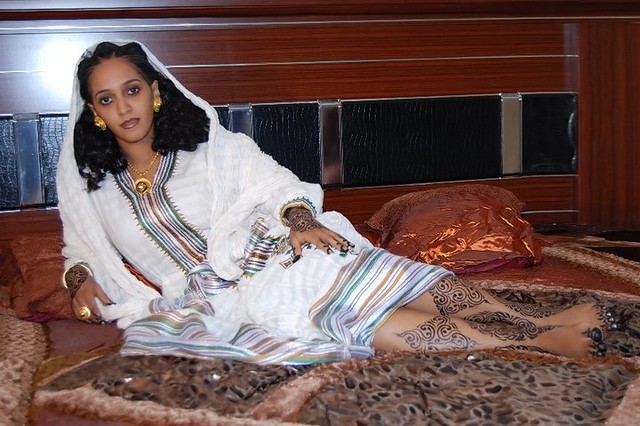
Ethiopian Habesha married woman

Habesha wedding
Beautiful Habesha bridesmaids
Habesha bride at Melsa
Artistic Impression of Emperor Ezana
Habesha jewelery


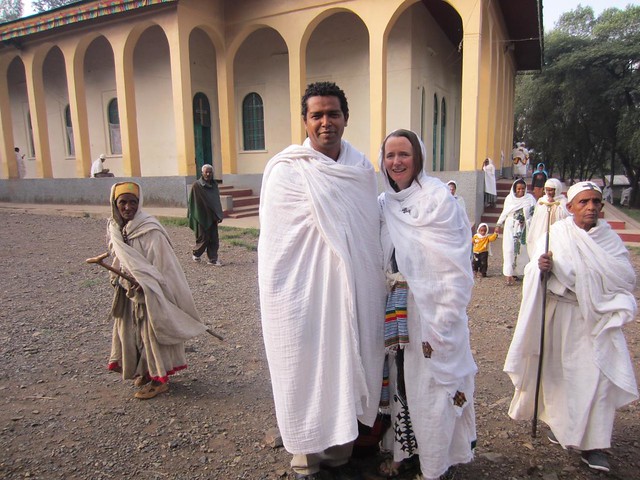

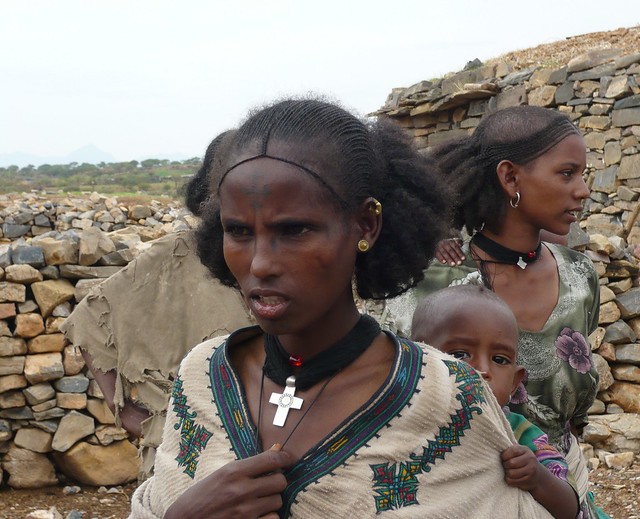
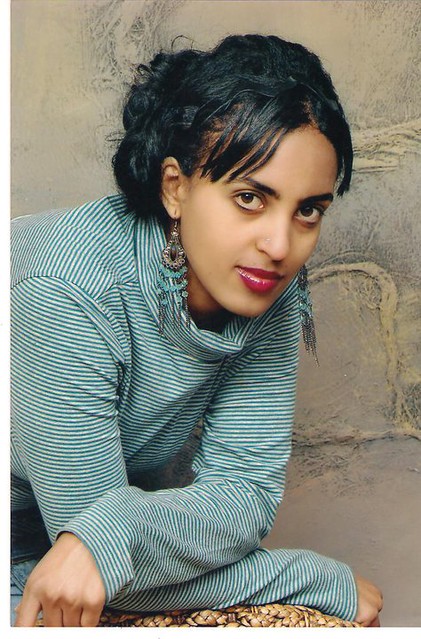

Eritrean habesha wedding
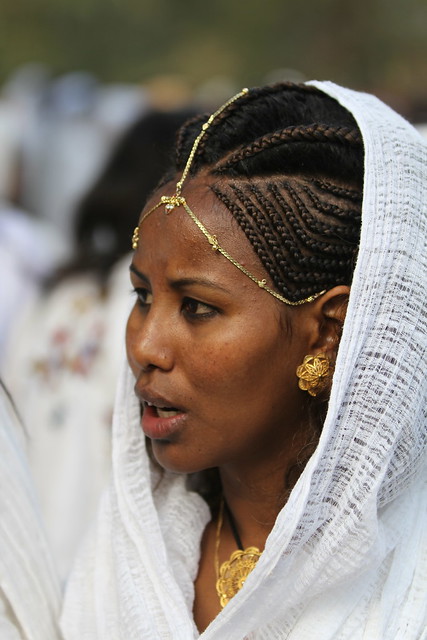
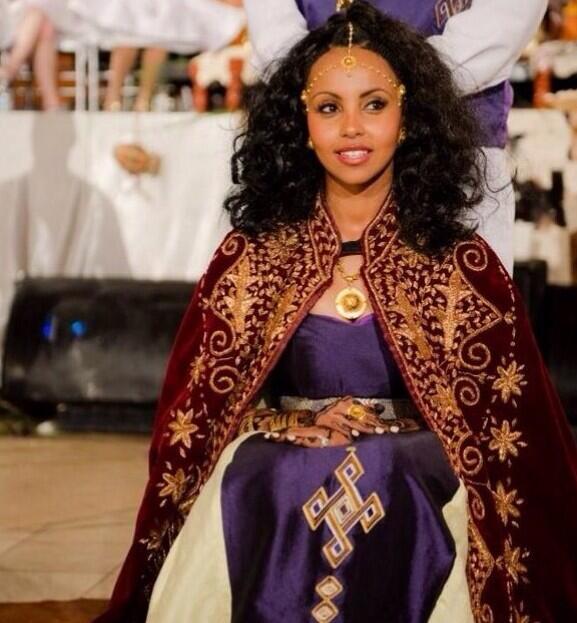
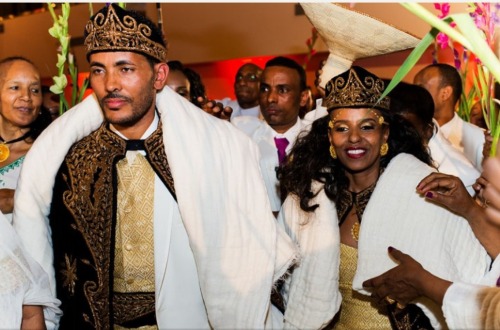


Emperor Menelik II








0 comments:
Post a Comment